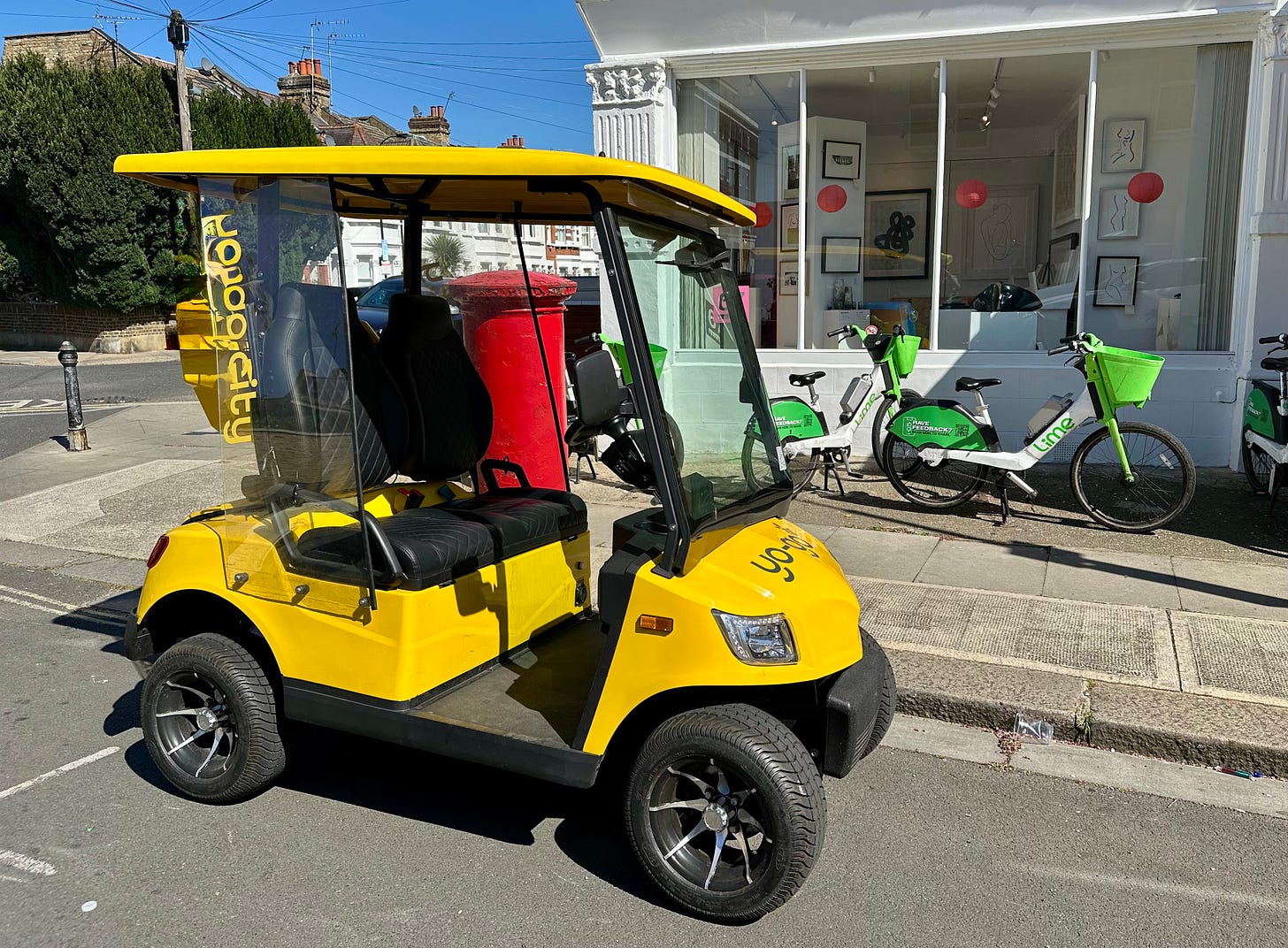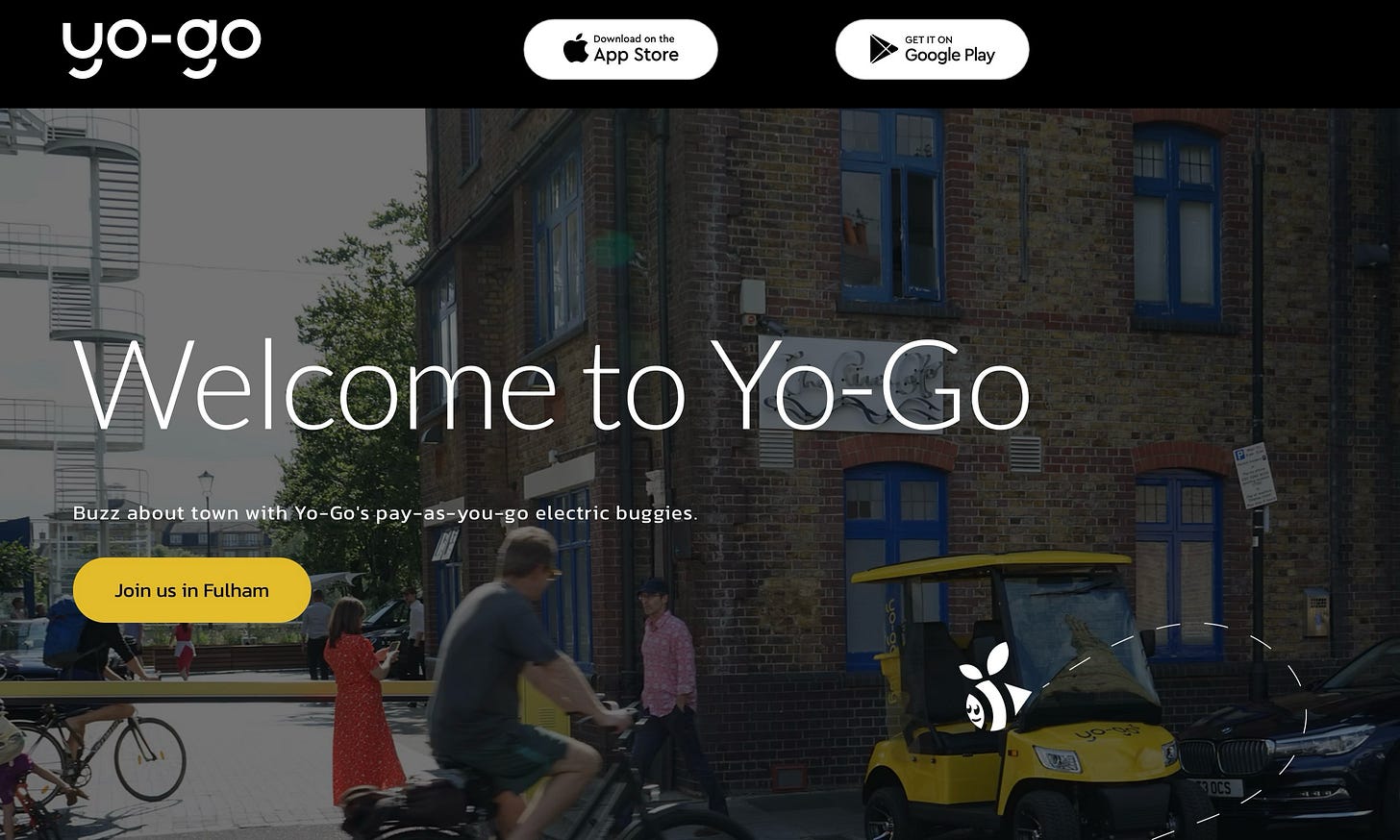What role neighbourhood electric vehicles?
First there were e-bikes and then e-scooters, now e-buggies in a world-first trial on the other side of the Thames - story 65
I spotted one of these buggies on my way to Craven Cottage to see Fulham play Liverpool in the Premier League. A vivid yellow spectacle on an otherwise white and red day. We won, thank you for asking.
Welcome to the Yo-Go buggies.
There are so many things to like about these Neighbourhood Electric Vehicles or NEVs. While their cheerful design might suggest a toy-like presence, these vehicles are part of a serious transportation experiment.
Experiment then scale: a lesson from technology
Having spent nearly twenty years in software, one of the most valuable lessons I learned was this: experiment first, then scale. With software, this is second nature — tweak a webpage layout, monitor user behaviour, compare outcomes, and expand what works. Experiment and scale.
One of the most striking aspects of urban design including transportation is the lack of experimentation. I can think of one notable example locally. The Barnes Parklet. There should be more.
That’s what makes the Yo-Go rollout refreshing — it’s a tangible attempt to test a new urban mobility concept on a manageable scale.
Addresses resident’s need
Dr Sam Bailey, CEO of Yo-Go, says the buggies aren’t intended to replace e-scooters or shared bikes, though some crossover might occur. “What we’re hoping is that they’ll be more of a replacement for cars,” Bailey explains.
With seat belts, a roof, and plenty of space for the shopping, the design prioritises comfort and convenience in a way famliar to anyone who has driven. And the premise is simple: most journeys in London are under three miles. For many, a small electric buggy could be quicker, cleaner, and less effort than hopping in the car.
They may also appeal to the 58% of Londoners who don’t own a car at all.
Playing to local strengths
Hammersmith & Fulham Council (H&F) are rightly proud of having 2,300 lamppost-column charging points, the
largest network of on-street charging points in London providing over 300 destination charge points offering either a 7 or 22 kWh charge
In other words: if you were designing a borough to test a scheme like Yo-Go, you’d want it to look a lot like H&F.
Simple to use
Drivers must be aged between 25 and 70 — a stipulation from the insurers. Beyond that, it’s easy: download the app, register, and pick up a buggy from one of several hubs, visible on your phone.
The pricing is straightforward: 20p per minute, or choose a subscription. The experience is somewhere between a Lime bike and a compact golf cart. One pedal reads “STOP,” the other “GO.” There’s room in the back for two large shopping bags.
The buggies are fully insured, and the company takes care of all the maintenance and the recharging.
Twenty’s plenty
The buggies are limited to 20mph. That is fast enough. It is faster than my e-bike which is capped at 15.9mph.
Each buggy has 35 miles of solar powered, zero exhaust emissions. Although if it is sunny it can run longer because of a rooftop solar panel.
Easy to park .. and free
The buggies are small and clearly manoeurvrable. The wheels sit outside the chassis so it corners and parks well. Its size means it can even be left kerb-on if necessary.
Better still, parking is free in H&F.
Council support
I disagree with H&F about Hammersmith Bridge: their leader has demanded the Bridge be restored to cars from the first day of its closure. But I support this and its other green initiatives. Kudos to them
This report from Tom Edwards, BBC London gives a good sense of the driving experience.
Like e-bikes and e-scooters before them, these buggies may seem like a novelty now. But change comes fast. Around half of Londoners aged 18–34 now use shared e-bikes at least once a week, and one in three rides is a work commute.
Big behavioural change can happen.


